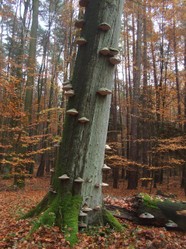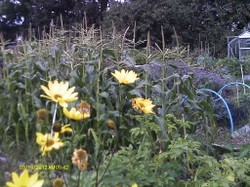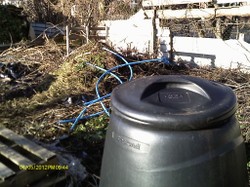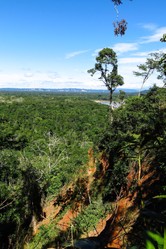Firstly, you do not have to rely on nature alone for your mycorrhiza, for you can purchase them from various stores. Applying the fungi is easy. When you dig your planting hole, sprinkle the fungus in it. Some growers suggest that the night before you plant you moisten the rootball by immersing it in water in which the fungal spores have been put. This gives them time to coat the rootball, and the results will be good for your plants, but it is sufficient to spread the powder. Some growers use a spray. It is important that the fungus is in contact with the roots, as it is still in spore form when applied, but contact with root exudates causes the fungal spores to germinate, which is what you want.
But there are implications for horticultural and agricultural practice. Scientists have noted that when soils are dug the levels of fungal presence deteriorate as the networks are broken up. Deep ploughing is detrimental to fungal well being. This has been seized by the no dig school of horticulture, but there are times when you need to dig,plough or harrow. My personal preference is the limited digging model, in which you only dig and plough when necessary. Some form of digging is necessary if you want to create tilth, the fine soil in which vegetables thrive, and you need to dig when you plant potatoes and other root crops. Digging also replicates the work of rooting animals, such as pigs, which are a natural part of the ecosystem, so some digging cannot be harmful, just do not do too much of it.
There is also the need for farmers and gardeners to apply compost properly. Patience is the key. Don't hurry your compost, allow it to ripen over a few months, for the heating of the heap destroys soil fungi, but the slow ripening process allows them to return from the soil beneath the compost heap and recolonize it. Farmers, who have been no great users of compost, are now looking seriously at it as they are recognizing its value. There is also biochar,that wonderful soil enhancer, for it is thought to be excellent for the development of glomalin in the soil. If you apply both compost and biochar then you are likely to develop a good fungal network in your soil.
But there is another strategy that we should follow:minimize the use of artificial fertilizers, for fungi cannot stand them, which is why when these artificial substances are used, fungal levels drop.Mary Reynolds, writing in The Garden Awakening, speaks of how the white explosions of mushrooms that coated Ireland's fields in Autumn [Fall] are now gone, as the farmers began to apply artificial fertilizer instead of manure. These mushrooms provided a source of food for some people, and their loss is not a blessing.









 Pilgrimage. A review23 days ago
Pilgrimage. A review23 days ago
 Leo the Fourteenthon 05/09/2025
Leo the Fourteenthon 05/09/2025
 The Melsonby Hoardon 03/25/2025
The Melsonby Hoardon 03/25/2025




Comments
Yes. It is the British way. Fallen trees are usually left for the fungi.
Thank you for your comment below in answer to my previous observation and question.
Arborist News for August 2024 has as its continuing education unit (CEU) article Taking an ecosystem approach to tree management, by Johan Östberg of Sweden's The Tree Office and Vikki Bengtsson of Sweden's ProNatura.
The article judges aging, dead woody plants, be they fallen or standing tree parts or trees, as pro-biodiversity, pro-carbon sequestration, pro-nutrient cycling and pro-wildlife conservation and habitat.
Both articles opine in favor of reducing or removing the above urban-forest configurations only if they offer unaesthetics or danger.
Would that seem to be the trend in the British Isles?
Ýes, several plants have leaves of their texture.
Thank you for your correction of the errant spell-checker, in answer to my previous observation and question.
Leaf size and texture convince me that holly and laurel leaves deserve pre-compost shredding -- with something other than scissors ;-D -- procedures.
Might there be other species equally resistant, without some kind of processing such as shredding, to smooth, swift composting?
A c o m p o s t e r.
Thank you for your comment below in answer to my previous observation and question.
The spelling checker has rendered your sentence as "put into a hot composted."
What is supposed to have appeared instead of that hanging adjective/past participle?
I was only talking about this subject with a friend yesterday, and what you said about holly came up then. I said that it was best shredded and put into a hot composted. I agree on ericaceous leaves.
Re-reading your wizzley with this re-visit brought to mind what I'd meant to ask previously.
In your comment below, you consider leafmold.
The article How to Make Leafmold - Gardener's Gold, by Benedict Vanheems Oct. 7, 2011, for GrowVeg declares beech, hornbeam and oak leaves and then horse and sweet chestnut, sycamore and walnut leaves as quality leafmold. He dismisses holly and laurel leafmold, which he recommends instead for shredding into compost heaps. He suggests pine needles as leafmold for blueberry shrubs and other ericaceous plants.
Would all that sound correct to you? And would they, or something else, be what you'd prioritize for leafmold?
Mainly compost and chicken manure pellets, but I also use leaf mould and seaweed [meal and liquid]. I have used worm compost in the past. I have used horse manure, but at 70 I find it now a bit heavy. Liquid feed for tomatoes at times
frankbeswick, Thank you for the practical information, pretty picture and product line.
What do you put mostly into your garden as compost, and have you done vermicomposting?
Not one of my gardens, starting with my popcorn garden before going into kindergarten, ever involved artificial fertilizers.